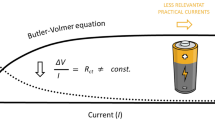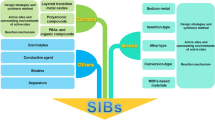Abstract
The effect of the liquid aprotic electrolyte composition on the performance of Li batteries with the polyimide (PI) cathode is studied. The electrolyte systems containing 1 М LiN(CF3SO2)2 (LiTFSI) in the dioxolane/dimethoxyethane mixture (2 : 1) and 1 М LiPF6 in ethylene carbonate/dimethyl carbonate mixture (1 : 1) are considered. The Li//PI cells are investigated by the methods of cyclic voltammetry (CV), staircase potential electrochemical impedance spectroscopy, and galvanostatic cycling. The electrochemical impedance studies of Li//Li cells show that the resistance of the solid electrolyte layer at the lithium electrode interface with the LiPF6 electrolyte is one-order-of-magnitude higher as compared with the layer formed at its interface with the LiTFSI electrolyte. The scanning electron microscopic (SEM) data confirm that such layer forms on the PI cathode too. The CV results demonstrate that the electrolyte composition strongly affects the reversibility of redox processes. By cycling the prototypes of Li//PI batteries it is shown that the battery prototype with LiTFSI electrolyte exhibits the better stability of discharge capacity, which allows considering this electrolyte composition as promising for the Li-polyimide system.







Similar content being viewed by others
REFERENCES
Friebe, C., Lex-Balducci, A., and Schubert, U.S., Sustainable energy storage: Recent trends and developments toward fully organic batteries, Chem. Sus. Chem., 2019, vol. 12, p. 4093.
Oubaha, H., Gohy, J.-F., and Melinte, S., Carbonyl-based π-conjugated materials: From synthesis to applications in lithium-ion batteries, Chem. Plus. Chem., 2019, vol. 84, p. 1179.
Haupler, B., Wild, A., and Schubert, U.S., Carbonyls: powerful organic materials for secondary batteries, Adv. Energy Mater., 2015, vol. 5, p. 1402034.
Song, Z., Zhan, H., and Zhou, Y., Polyimides: promising energy-storage materials, Angew. Chem., Int. Ed., 2010, vol. 49, p. 8444.
Luo, J., Zhu, Y.N., Yan, C., Long, X.-Y., Lu, S., Liu, S.-P., and Ge, M.-Q., Preparation of organic polymer cathode materials for amide lithium-ion battery anode and their electrochemical performance, Acta Polym. Sin., 2017, vol. 4, p. 633.
Reiner, B.R., Foxman, B.M., and Wade, C.R., Electrochemical and structural investigation of the interactions between naphthalene diimides and metal cations, Dalton T., 2017, vol. 46, iss. 29, p. 9472.
Schon, T.B., Tilley, A.J., Kynaston, E.L., and Seferos, D.S., Three-dimensional arylene diimide frameworks for highly stable lithium ion batteries, ACS Appl. Mater. Interfaces, 2017, vol. 9, no.18, p. 15631.
Sharma, P., Damien, D., Nagarajan, K., Shaijumon, M.M., and Hariharan, M., Perylene-polyimide-based organic electrode materials for rechargeable lithium batteries, J. Phys. Chem. Lett., 2013, vol. 4, p. 3192.
Chen, C., Zhao, X., Li, H.-B., Gan, F., Zhang, J., Dong, J., and Zhang, Q., Naphthalene-based polyimide derivatives as organic electrode materials for lithium-ion batteries, Electrochim. Acta, 2017, vol. 229, p. 387.
Chen, L., Li, W., Wang, Y., Wang, C., and Xia, Y., Polyimide as anode electrode material for rechargeable sodium batteries, RSC Adv., 2014, vol. 4, p. 25369.
Dong, X., Yu, H., Ma, Y., Bao, J., Truhlar, D.G., Wang, Y., and Xia, Y., All-organic rechargeable battery with reversibility supported by “water-in-salt” electrolyte, Chem. Eur. J., 2017, vol. 23, p. 2560.
Song, Z., Xu, T., Gordin, M.L., Jiang, Y.B., Bae, I.T., Xiao, Q., Zhan, H., Liu, J., and Wang, D., Polymer-graphene nanocomposites as ultrafast-charge and -discharge cathodes for rechargeable lithium batteries, Nano Lett., 2012, vol. 12, p. 2205.
Chen, L., Bao, J.L., Dong, X., Truhlar, D.G., Wang, Y., Wang, C., and Xia, Y., Aqueous Mg-ion battery based on polyimide anode and Prussian Blue cathode, ACS Energy Lett., 2017, vol. 2, p. 1115.
Gheytani, S., Liang, Y., Wu, F., Jing, Y., Dong, H., Rao, K.K., Chi, X., Fang, F., and Yao, Y., An aqueous Ca-ion battery, Adv. Sci., 2017, vol. 4, p. 1700465.
Huang, Y., Li, K., Liu, J., Zhong, X., Duan, X., Shakir, I., and Xu, Y., Three-dimensional graphene/polyimide composite-derived flexible high-performance organic cathode for rechargeable lithium and sodium batteries, J. Mater. Chem. A, 2017, vol. 5, p. 2710.
Shestakov, A.F., Yarmolenko, O.V., Ignatova, A.A., Mumyatov, A.V., Stevenson, K.J., and Troshin, P.A., Structural origins of the capacity fading in the lithium- polyimide battery, J. Mater. Chem. A, 2017, vol. 5, p. 6532.
Shestakov, A.F., Romanuyk, O.E., Mumyatov, A.V., Luchkin, S.Yu., Slesarenko, A.A., Yarmolenko, O.V., Stevenson, K.J., and Troshin, P.A., Theoretical and experimental evidence for irreversible lithiation of conformationally flexible polyimide: impact on the battery performance, J. Electroanal. Chem., 2019, vol. 836, p. 143.
Yarmolenko, O.V., Romanyuk, O.E., Slesarenko, A.A., Baymuratova, G.R., Shuvalova, N.I., Mumyatov, A.V., Troshin, P.A., and Shestakov, A.F., Performance of a Li-polyimide battery with electrolytes of various types, Russ. J. Electrochem., 2019, vol. 55, p. 254.
Liang, Y., Zhang, P., and Chen, J., Function-oriented design of conjugated carbonyl compound electrodes for high energy lithium batteries, Chem. Sci., 2013, vol. 4, p. 1330.
Lv, M., Zhang, F., Wu, Y., Chen, M., Yao, C., Nan, J., Shu, D., Zeng, R., Zeng, H., and Chou, S.-L., Heteroaromatic organic compound with conjugated multi-carbonyl as cathode material for rechargeable lithium batteries, Sci. Rep., 2016, vol. 6, p. 23515.
Hernández, G., Casado, N., Coste, R., Shanmukaraj, D., Rubatat, L., Armand, M., and Mecerreyes, D., Redox-active polyimide–polyether block copolymers as electrode materials for lithium batteries, RSC Adv., 2015, vol. 5, p. 17096.
Xu, Z., Ye, H., Li, H., Xu, Y., Wang, C., Yin, J., and Zhu, H., Enhanced lithium ion storage performance of tannic acid in LiTFSI electrolyte, ACS Omega, 2017, vol. 2, p. 1273.
Kalhoff, J., Bresser, D., Bolloli, M., Alloin, F., Sanchez, J.-Y., and Passerini, S., Enabling LiTFSI-based electrolytes for safer lithium-ion batteries by using linear fluorinated carbonates as (Co) solvent, ChemSusChem, 2014, vol.7, p. 2939.
Lewandowski, A. and Świderska-Mocek, A., Ionic liquids as electrolytes for Li-ion batteries—An overview of electrochemical studies, J. Power Sources, 2009, vol. 194, p. 601.
Lahiri, A., Borisenko, N., Borodin, A., Olschewski, M., and Endres, F., Characterisation of the solid electrolyte interface during lithiation/delithiation of germanium in an ionic liquid, Phys. Chem. Chem. Phys., 2016, vol. 18, p. 5630.
ACKNOWLEDGMENTS
We are grateful to N.N. Dremova (Analytical Center of Collective Use, Institute of Problems of Chemical Physics, Russian Academy of Sciences) for studying the surface of cathodes by the SEM method.
Funding
This work was supported by the Ministry of Science and Higher Education of the Russian Federation, project no. АААА-А19-119071190044-3.
Author information
Authors and Affiliations
Corresponding authors
Ethics declarations
The authors declare that they have no conflict of interest.
Additional information
Translated by T. Safonova
Based on the materials of the report at the 15th International Meeting “Fundamental Problems of Solid State Ionics”, Chernogolovka, 30.11.–07.12.2020.
Rights and permissions
About this article
Cite this article
Baymuratova, G.R., Mumyatov, A.V., Kapaev, R.R. et al. The Effect of Electrolyte Composition on the Parameters of Batteries of the Polyimide–Lithium System. Russ J Electrochem 57, 725–732 (2021). https://doi.org/10.1134/S102319352107003X
Received:
Revised:
Accepted:
Published:
Issue Date:
DOI: https://doi.org/10.1134/S102319352107003X




